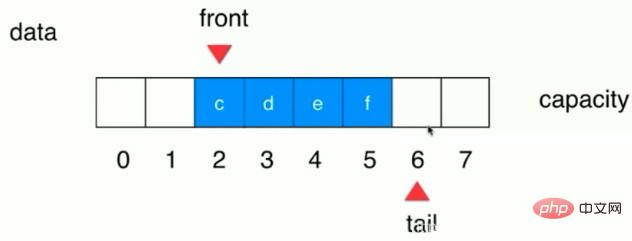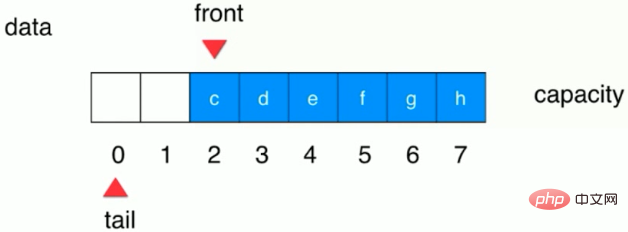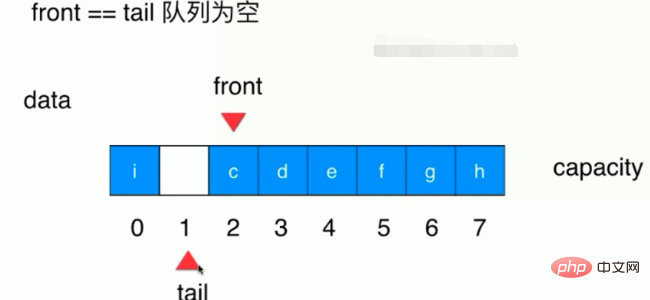Java implements circular queue

Advantages of circular queue
Ordinary queue dequeuing operations are expensive: during dequeuing operations, all elements after index 0 , all need to be moved forward by one position. The more elements there are, the more time is consumed, and the time complexity is O(N).
The logic of the circular queue:
1. When there are few elements (the tail position is behind the front), the circular queue has the same queuing operation as a normal queue. The element of the queue will be placed at the tail position, and then the tail operation will be performed; when the element is dequeued, the element at the front position will be set to null, and then the front operation will be performed; at this time, the tail position can still be maintained behind the front, as follows As shown in the figure:

#2. When elements continue to be added, the last element will be placed at index 7. At this time, the tail position will move to the index in front of the head of the queue. At the position of 0, the index of tail in the array becomes: (tail 1)% capacity as shown in the figure below:

3. When elements continue to be added , the element will be added at the tail position, and the tail will continue to move backward, as shown in the following figure:

#4. Continue to add elements when the tail and front are still one unit apart. At this time, that is, there is still a free storage space in the array, but the current array can no longer implement the insertion operation of the circular queue, because the condition for the circular queue to judge that the queue is empty is front == tail, so expansion operation is required at this time; So there is a conscious waste of space here.
It can be deduced here that the condition for the circular queue element to be full is: tail 1 == front (preliminary conclusion, it will be improved to (tail 1) % capacity == front)
5 . Under appropriate circumstances, if the dequeue operation continues, the position of front will also jump from the right end of the array to the left end of the array. At this time, the index of front in the array becomes: (front 1)% capacity
Code implementation: (Related video tutorial sharing: java video tutorial)
package dataStructure.chapter3;
/**
* @Author: zjtMeng
* @Date: 2019/12/28 20:13
* @Version 1.0
*/
public class LoopQueue<E> implements Queue<E> {
private E[] data;
private int front,tail;
private int size;
public LoopQueue(int capacity){
data = (E[]) new Object[capacity+1];
}
public LoopQueue(){
this(10);
}
public int getCapacity(){
return data.length-1;
}
/**
* 循环队列入队操作
* @param e
*/
@Override
public void enqueue(E e) {
//循环队列元素满的判断条件,如果满了就进行扩容操作,扩大两倍
if ((tail+1)%data.length == front)
resize(2 * getCapacity());
data[tail] = e;
tail = (tail + 1) % data.length;
size ++;
}
/**
* 循环队列扩容
* @param newCapacity
*/
private void resize(int newCapacity){
E[] newData = (E[]) new Object[newCapacity+1];
//循环队列第一种遍历方式
for (int i = 0 ; i < size ; i++ ){
//newData[]中的元素与data[]中的元素,一方面存在着front的偏移量,另一方面,data[]中的元素,
//可能在有部分处于front前面,因此此处采用对数组长度取余,来判断元素的位置
newData[i] = data[(i+front)%data.length];
}
data = newData;
front =0;
tail = size;
}
@Override
public E dequeue() {
//首先判断队列是否为空,如果为空则抛出异常
if (isEmpty())
throw new IllegalArgumentException("Cannot dequeue from an empty queue.");
E ret = data[front];
//引用地址需要置空,否则JVM不能及时回收空间,从而可能会出现OOM异常
data[front] = null;
front = (front + 1 )% data.length;
size--;
//如果元素数量达到队列容积的1/4,且队列容积/2 不等于0时,进行缩容操作
if (size == getCapacity() / 4 && getCapacity() / 2 != 0 )
resize(getCapacity() / 2);
return ret;
}
/**
* 查看队首元素
* @return
*/
@Override
public E getFront() {
if (isEmpty())
throw new IllegalArgumentException("Queue is empty.");
return data[front];
}
@Override
public int getSize() {
return size;
}
/**
* 判断循队列是否为空
* @return
*/
@Override
public boolean isEmpty() {
return front == tail;
}
@Override
public String toString(){
StringBuilder res = new StringBuilder();
res.append(String.format("Queue: size = %d, capacity = %d\n",size, getCapacity()));
res.append("front[");
//循环队列遍历的第二种方法
for (int i = front; i != tail; i = (i + 1) % data.length){
res.append(data[i]);
//循环队列未遍历到队尾的标志
if ((i + 1) % data.length != tail)
res.append(", ");
}
res.append("] tail");
return res.toString();
}
}Recommended related articles and tutorials: java introductory tutorial
The above is the detailed content of Java implements circular queue. For more information, please follow other related articles on the PHP Chinese website!

Hot AI Tools

Undresser.AI Undress
AI-powered app for creating realistic nude photos

AI Clothes Remover
Online AI tool for removing clothes from photos.

Undress AI Tool
Undress images for free

Clothoff.io
AI clothes remover

Video Face Swap
Swap faces in any video effortlessly with our completely free AI face swap tool!

Hot Article

Hot Tools

Notepad++7.3.1
Easy-to-use and free code editor

SublimeText3 Chinese version
Chinese version, very easy to use

Zend Studio 13.0.1
Powerful PHP integrated development environment

Dreamweaver CS6
Visual web development tools

SublimeText3 Mac version
God-level code editing software (SublimeText3)

Hot Topics
 1666
1666
 14
14
 1426
1426
 52
52
 1328
1328
 25
25
 1273
1273
 29
29
 1254
1254
 24
24
 Break or return from Java 8 stream forEach?
Feb 07, 2025 pm 12:09 PM
Break or return from Java 8 stream forEach?
Feb 07, 2025 pm 12:09 PM
Java 8 introduces the Stream API, providing a powerful and expressive way to process data collections. However, a common question when using Stream is: How to break or return from a forEach operation? Traditional loops allow for early interruption or return, but Stream's forEach method does not directly support this method. This article will explain the reasons and explore alternative methods for implementing premature termination in Stream processing systems. Further reading: Java Stream API improvements Understand Stream forEach The forEach method is a terminal operation that performs one operation on each element in the Stream. Its design intention is
 PHP: A Key Language for Web Development
Apr 13, 2025 am 12:08 AM
PHP: A Key Language for Web Development
Apr 13, 2025 am 12:08 AM
PHP is a scripting language widely used on the server side, especially suitable for web development. 1.PHP can embed HTML, process HTTP requests and responses, and supports a variety of databases. 2.PHP is used to generate dynamic web content, process form data, access databases, etc., with strong community support and open source resources. 3. PHP is an interpreted language, and the execution process includes lexical analysis, grammatical analysis, compilation and execution. 4.PHP can be combined with MySQL for advanced applications such as user registration systems. 5. When debugging PHP, you can use functions such as error_reporting() and var_dump(). 6. Optimize PHP code to use caching mechanisms, optimize database queries and use built-in functions. 7
 PHP vs. Python: Understanding the Differences
Apr 11, 2025 am 12:15 AM
PHP vs. Python: Understanding the Differences
Apr 11, 2025 am 12:15 AM
PHP and Python each have their own advantages, and the choice should be based on project requirements. 1.PHP is suitable for web development, with simple syntax and high execution efficiency. 2. Python is suitable for data science and machine learning, with concise syntax and rich libraries.
 PHP vs. Other Languages: A Comparison
Apr 13, 2025 am 12:19 AM
PHP vs. Other Languages: A Comparison
Apr 13, 2025 am 12:19 AM
PHP is suitable for web development, especially in rapid development and processing dynamic content, but is not good at data science and enterprise-level applications. Compared with Python, PHP has more advantages in web development, but is not as good as Python in the field of data science; compared with Java, PHP performs worse in enterprise-level applications, but is more flexible in web development; compared with JavaScript, PHP is more concise in back-end development, but is not as good as JavaScript in front-end development.
 PHP vs. Python: Core Features and Functionality
Apr 13, 2025 am 12:16 AM
PHP vs. Python: Core Features and Functionality
Apr 13, 2025 am 12:16 AM
PHP and Python each have their own advantages and are suitable for different scenarios. 1.PHP is suitable for web development and provides built-in web servers and rich function libraries. 2. Python is suitable for data science and machine learning, with concise syntax and a powerful standard library. When choosing, it should be decided based on project requirements.
 PHP's Impact: Web Development and Beyond
Apr 18, 2025 am 12:10 AM
PHP's Impact: Web Development and Beyond
Apr 18, 2025 am 12:10 AM
PHPhassignificantlyimpactedwebdevelopmentandextendsbeyondit.1)ItpowersmajorplatformslikeWordPressandexcelsindatabaseinteractions.2)PHP'sadaptabilityallowsittoscaleforlargeapplicationsusingframeworkslikeLaravel.3)Beyondweb,PHPisusedincommand-linescrip
 PHP: The Foundation of Many Websites
Apr 13, 2025 am 12:07 AM
PHP: The Foundation of Many Websites
Apr 13, 2025 am 12:07 AM
The reasons why PHP is the preferred technology stack for many websites include its ease of use, strong community support, and widespread use. 1) Easy to learn and use, suitable for beginners. 2) Have a huge developer community and rich resources. 3) Widely used in WordPress, Drupal and other platforms. 4) Integrate tightly with web servers to simplify development deployment.
 PHP vs. Python: Use Cases and Applications
Apr 17, 2025 am 12:23 AM
PHP vs. Python: Use Cases and Applications
Apr 17, 2025 am 12:23 AM
PHP is suitable for web development and content management systems, and Python is suitable for data science, machine learning and automation scripts. 1.PHP performs well in building fast and scalable websites and applications and is commonly used in CMS such as WordPress. 2. Python has performed outstandingly in the fields of data science and machine learning, with rich libraries such as NumPy and TensorFlow.




